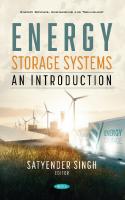Energy Storage And Civilization: A Systems Approach 3030330923, 9783030330927, 9783030330934
Fossil fuels comprise the accumulation of prehistoric biomass that was energised by sunlight, and formed by earth system
370 59 2KB
English Pages 186 Year 2020
Table of contents :
Preface......Page 6
Introduction......Page 8
Contents......Page 11
1.1 The Argument for the Primacy of Energy Storage......Page 15
1.2.2 The Crucial Advantage of Grains and Cereals......Page 17
1.2.3 Why Farm?......Page 18
1.2.4 The Paradoxes of the Neolithic Transition......Page 20
1.3.1 Energy Storage as a Pivotal Factor in Post-Palaeolithic Evolution......Page 21
1.3.2 Surplus Energy and Energy Storage......Page 23
1.3.3 Counter-Examples......Page 24
1.4.1 Salt as Food Preservative and Commodity Money......Page 25
1.4.2 Rice......Page 26
1.4.5 Metallic Commodities......Page 27
1.5 The First Complex State Societies......Page 28
1.6.1 Coal and Steam Power......Page 30
1.6.2 British Empire......Page 33
1.7.1 Crude Oil......Page 35
1.7.3 Oil and Currencies......Page 36
1.7.4 Oil and Economic Growth......Page 38
1.8.1 Electricity Compared to Gasoline......Page 40
1.9 Summary......Page 41
2.2 Photosynthesis and Oxygen......Page 43
2.3 The Formation of Fossil Fuels......Page 45
2.4.1 Introduction......Page 48
2.4.2 Hydrogen and Oxygen Combustion......Page 49
2.4.3 Methane Combustion......Page 51
2.5 Properties of Fossil Fuels......Page 52
2.6 Summary......Page 53
3.1.2 Forces and Work......Page 55
3.2 Energy in Nature......Page 57
3.3 End-Use Energy Services from a Human Perspective......Page 59
3.4 Energy Density......Page 60
3.5.2 Functional Equivalence......Page 65
3.5.3 Functional Units......Page 66
3.6.1 Commercial Fuels......Page 68
3.6.3 Interpretation of Primary Energy Results......Page 69
3.7 Summary......Page 70
4.2.1 Price Systems for Non-buffered Electricity Flows......Page 71
4.2.2 Historical Evolution of Electricity Markets......Page 72
4.3.1 Competing Objectives......Page 74
4.3.4 Misalignment of Biophysical and Monetary Value......Page 75
4.3.6 Congestion Management......Page 76
4.3.7 Storage Scale......Page 77
4.4.1 Introduction......Page 78
4.4.2 Biophysical Economics in Context......Page 79
4.4.3 Objectivist Versus Marginalist Conceptions of Value......Page 80
4.4.4 EROI as a Specialized Energy Productivity Metric......Page 82
4.5 Summary......Page 84
5.2 Approaches to Analysing EROI for Systems with IntegratedStorage......Page 85
5.3 Energy Costs of Storage......Page 88
5.5 Reversibility and Irreversibility......Page 90
5.6.1.1 Context......Page 93
5.6.1.3 P2G System......Page 94
5.6.1.4 P2G Conversion Efficiency Summary......Page 95
5.6.2.1 Context......Page 96
5.6.2.2 PHS and Battery Conversion Efficiency Summary......Page 97
5.6.3.2 Solar PV as a Consumer Product......Page 98
5.6.3.3 Dynamic EROI......Page 99
5.7 The Concept of a `Minimum EROI for Society'......Page 100
5.8 Summary......Page 101
6.2 Global Storage Context......Page 103
6.3 Historical Role of Electrical Energy Storage......Page 105
6.4.1 Dispatchability......Page 108
6.4.2 Capacity Firming......Page 109
6.4.3 Frequency Regulation......Page 110
6.4.4 Spinning Reserve......Page 112
6.5 Supply Continuity......Page 115
6.6.1 Forced Outage Rate......Page 116
6.6.2 Loss-of-Load-Expectation (LOLE)......Page 118
6.7.1 Inertia......Page 119
6.7.2 Reactive Power......Page 120
6.8 Summary......Page 122
7.1 Introduction......Page 123
7.2 Scenario Modelling Approaches......Page 124
7.3 Strategies for Balancing Supply and Demand......Page 125
7.4 Fossil Fuel Energy Storage as a Reference for Required Capacity......Page 129
7.5.1 Introduction......Page 131
7.5.2 Macroeconomic Modelling Is Not Compatible with Thermodynamic Laws......Page 132
7.5.3 Models Are Too Narrow......Page 133
7.5.4 Reliability......Page 134
7.5.5 A Layered Approach to Modelling......Page 135
7.6 Summary......Page 138
8.1.1 Introduction......Page 139
8.1.2 A Moonshot......Page 140
8.1.3 Hydrogen Carriers......Page 141
8.2.1 Water, Hydrogen and Oxygen......Page 142
8.2.2 Hydrogen Fuel Cell......Page 144
8.3 A Parallel Energy Supply Network Based on Hydrogen......Page 145
8.4 Challenges Faced in Adopting Hydrogen as a Large-Scale Energy Carrier......Page 146
8.5 EROI for Hydrogen as an Energy Carrier......Page 148
8.6 Reframing Our Understanding of Efficiency......Page 149
8.7 Summary......Page 150
9.2 The Magnitude of the Problem We Face......Page 152
9.2.1 Electric Vehicle Batteries Replacing Petroleum Storage......Page 153
9.2.2 Pumped Hydro Storage......Page 155
9.2.3 Reconciling the Storage Challenge......Page 156
9.3 History Through an Energy Storage Lens......Page 157
9.4 The Quest for a Universal Energy Storage and DistributionMedium......Page 158
9.5.1 A Global Grid as a Solution to Storage......Page 159
9.5.2 A General Purpose Technological Storage Device......Page 161
9.5.3 Large Scale Substitution of Petroleum with Biofuels......Page 162
9.5.4 Hydrogen Economy......Page 164
9.5.5 Renewable Overbuild and Demand Management......Page 165
9.5.6 Energy Descent......Page 166
9.6 Conclusions......Page 168
Bibliography......Page 170
Index......Page 184
Preface......Page 6
Introduction......Page 8
Contents......Page 11
1.1 The Argument for the Primacy of Energy Storage......Page 15
1.2.2 The Crucial Advantage of Grains and Cereals......Page 17
1.2.3 Why Farm?......Page 18
1.2.4 The Paradoxes of the Neolithic Transition......Page 20
1.3.1 Energy Storage as a Pivotal Factor in Post-Palaeolithic Evolution......Page 21
1.3.2 Surplus Energy and Energy Storage......Page 23
1.3.3 Counter-Examples......Page 24
1.4.1 Salt as Food Preservative and Commodity Money......Page 25
1.4.2 Rice......Page 26
1.4.5 Metallic Commodities......Page 27
1.5 The First Complex State Societies......Page 28
1.6.1 Coal and Steam Power......Page 30
1.6.2 British Empire......Page 33
1.7.1 Crude Oil......Page 35
1.7.3 Oil and Currencies......Page 36
1.7.4 Oil and Economic Growth......Page 38
1.8.1 Electricity Compared to Gasoline......Page 40
1.9 Summary......Page 41
2.2 Photosynthesis and Oxygen......Page 43
2.3 The Formation of Fossil Fuels......Page 45
2.4.1 Introduction......Page 48
2.4.2 Hydrogen and Oxygen Combustion......Page 49
2.4.3 Methane Combustion......Page 51
2.5 Properties of Fossil Fuels......Page 52
2.6 Summary......Page 53
3.1.2 Forces and Work......Page 55
3.2 Energy in Nature......Page 57
3.3 End-Use Energy Services from a Human Perspective......Page 59
3.4 Energy Density......Page 60
3.5.2 Functional Equivalence......Page 65
3.5.3 Functional Units......Page 66
3.6.1 Commercial Fuels......Page 68
3.6.3 Interpretation of Primary Energy Results......Page 69
3.7 Summary......Page 70
4.2.1 Price Systems for Non-buffered Electricity Flows......Page 71
4.2.2 Historical Evolution of Electricity Markets......Page 72
4.3.1 Competing Objectives......Page 74
4.3.4 Misalignment of Biophysical and Monetary Value......Page 75
4.3.6 Congestion Management......Page 76
4.3.7 Storage Scale......Page 77
4.4.1 Introduction......Page 78
4.4.2 Biophysical Economics in Context......Page 79
4.4.3 Objectivist Versus Marginalist Conceptions of Value......Page 80
4.4.4 EROI as a Specialized Energy Productivity Metric......Page 82
4.5 Summary......Page 84
5.2 Approaches to Analysing EROI for Systems with IntegratedStorage......Page 85
5.3 Energy Costs of Storage......Page 88
5.5 Reversibility and Irreversibility......Page 90
5.6.1.1 Context......Page 93
5.6.1.3 P2G System......Page 94
5.6.1.4 P2G Conversion Efficiency Summary......Page 95
5.6.2.1 Context......Page 96
5.6.2.2 PHS and Battery Conversion Efficiency Summary......Page 97
5.6.3.2 Solar PV as a Consumer Product......Page 98
5.6.3.3 Dynamic EROI......Page 99
5.7 The Concept of a `Minimum EROI for Society'......Page 100
5.8 Summary......Page 101
6.2 Global Storage Context......Page 103
6.3 Historical Role of Electrical Energy Storage......Page 105
6.4.1 Dispatchability......Page 108
6.4.2 Capacity Firming......Page 109
6.4.3 Frequency Regulation......Page 110
6.4.4 Spinning Reserve......Page 112
6.5 Supply Continuity......Page 115
6.6.1 Forced Outage Rate......Page 116
6.6.2 Loss-of-Load-Expectation (LOLE)......Page 118
6.7.1 Inertia......Page 119
6.7.2 Reactive Power......Page 120
6.8 Summary......Page 122
7.1 Introduction......Page 123
7.2 Scenario Modelling Approaches......Page 124
7.3 Strategies for Balancing Supply and Demand......Page 125
7.4 Fossil Fuel Energy Storage as a Reference for Required Capacity......Page 129
7.5.1 Introduction......Page 131
7.5.2 Macroeconomic Modelling Is Not Compatible with Thermodynamic Laws......Page 132
7.5.3 Models Are Too Narrow......Page 133
7.5.4 Reliability......Page 134
7.5.5 A Layered Approach to Modelling......Page 135
7.6 Summary......Page 138
8.1.1 Introduction......Page 139
8.1.2 A Moonshot......Page 140
8.1.3 Hydrogen Carriers......Page 141
8.2.1 Water, Hydrogen and Oxygen......Page 142
8.2.2 Hydrogen Fuel Cell......Page 144
8.3 A Parallel Energy Supply Network Based on Hydrogen......Page 145
8.4 Challenges Faced in Adopting Hydrogen as a Large-Scale Energy Carrier......Page 146
8.5 EROI for Hydrogen as an Energy Carrier......Page 148
8.6 Reframing Our Understanding of Efficiency......Page 149
8.7 Summary......Page 150
9.2 The Magnitude of the Problem We Face......Page 152
9.2.1 Electric Vehicle Batteries Replacing Petroleum Storage......Page 153
9.2.2 Pumped Hydro Storage......Page 155
9.2.3 Reconciling the Storage Challenge......Page 156
9.3 History Through an Energy Storage Lens......Page 157
9.4 The Quest for a Universal Energy Storage and DistributionMedium......Page 158
9.5.1 A Global Grid as a Solution to Storage......Page 159
9.5.2 A General Purpose Technological Storage Device......Page 161
9.5.3 Large Scale Substitution of Petroleum with Biofuels......Page 162
9.5.4 Hydrogen Economy......Page 164
9.5.5 Renewable Overbuild and Demand Management......Page 165
9.5.6 Energy Descent......Page 166
9.6 Conclusions......Page 168
Bibliography......Page 170
Index......Page 184










![Energy Storage for Power Systems [3 ed.]
1785618679, 9781785618673](https://ebin.pub/img/200x200/energy-storage-for-power-systems-3nbsped-1785618679-9781785618673.jpg)